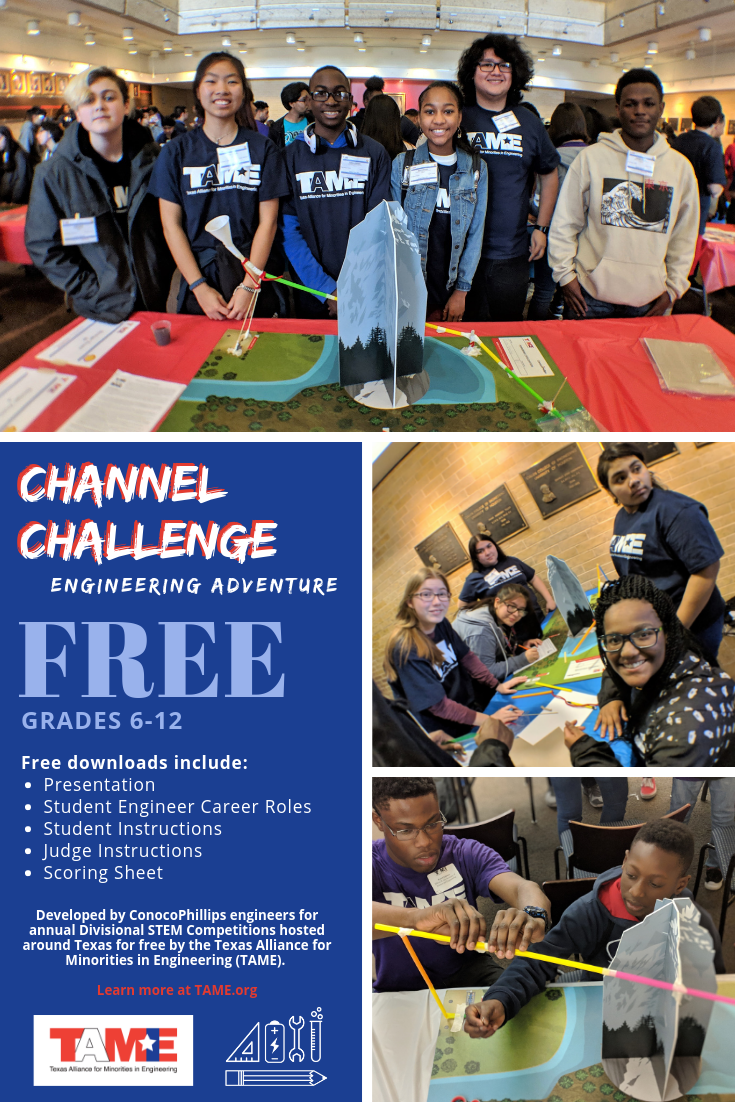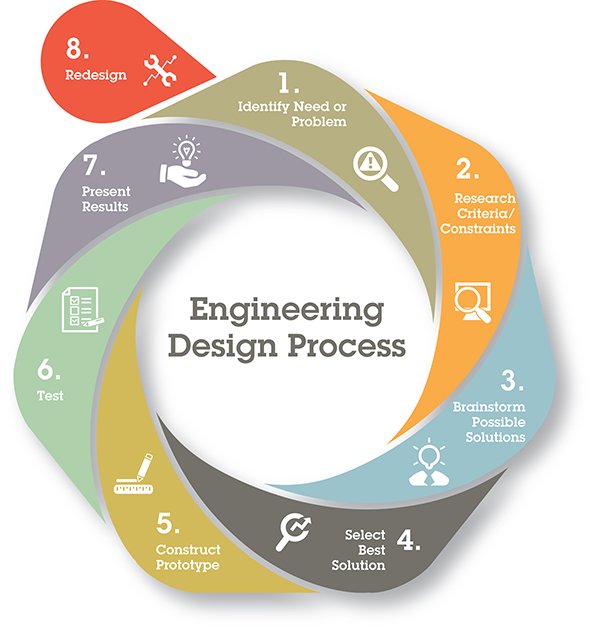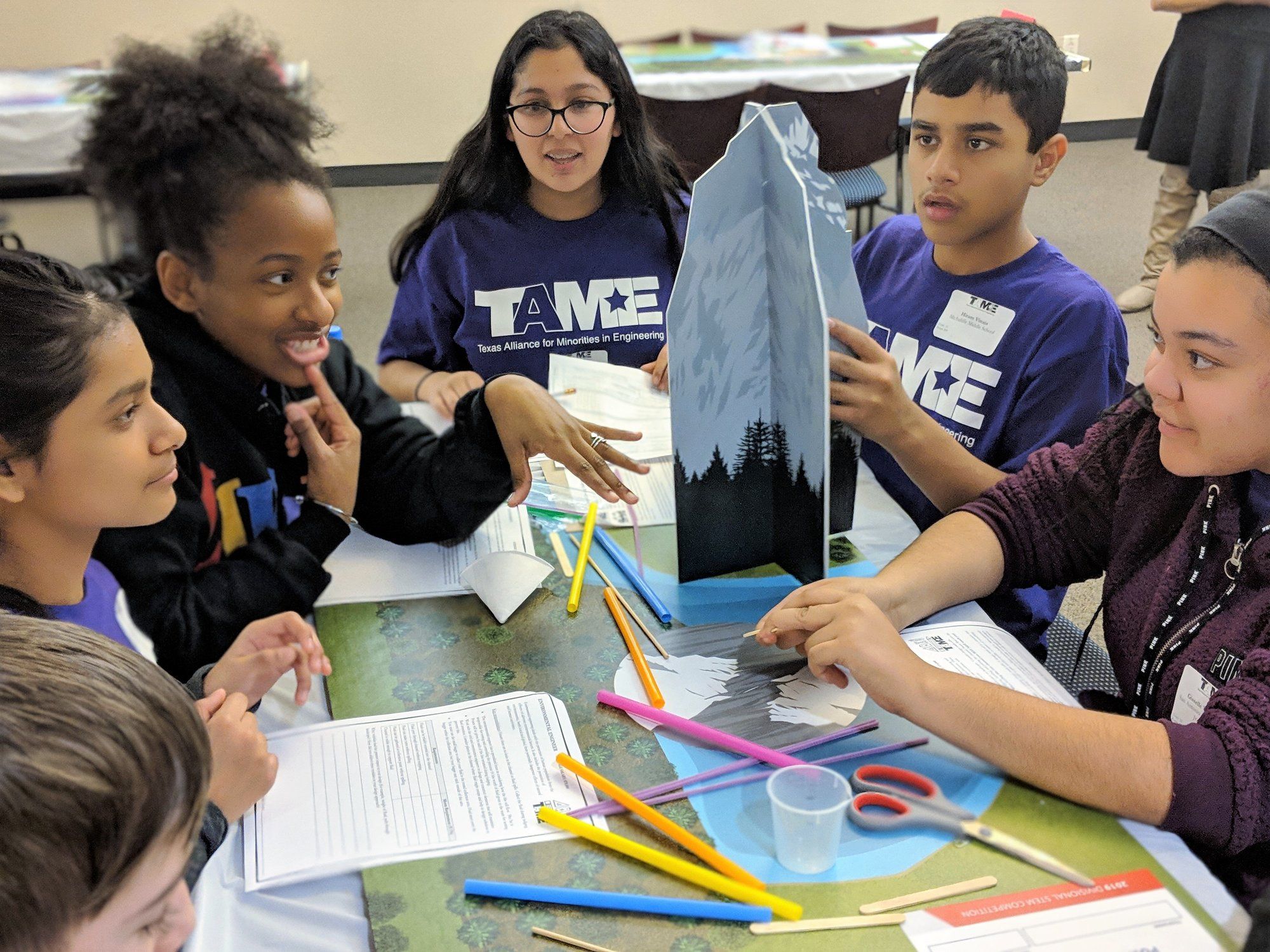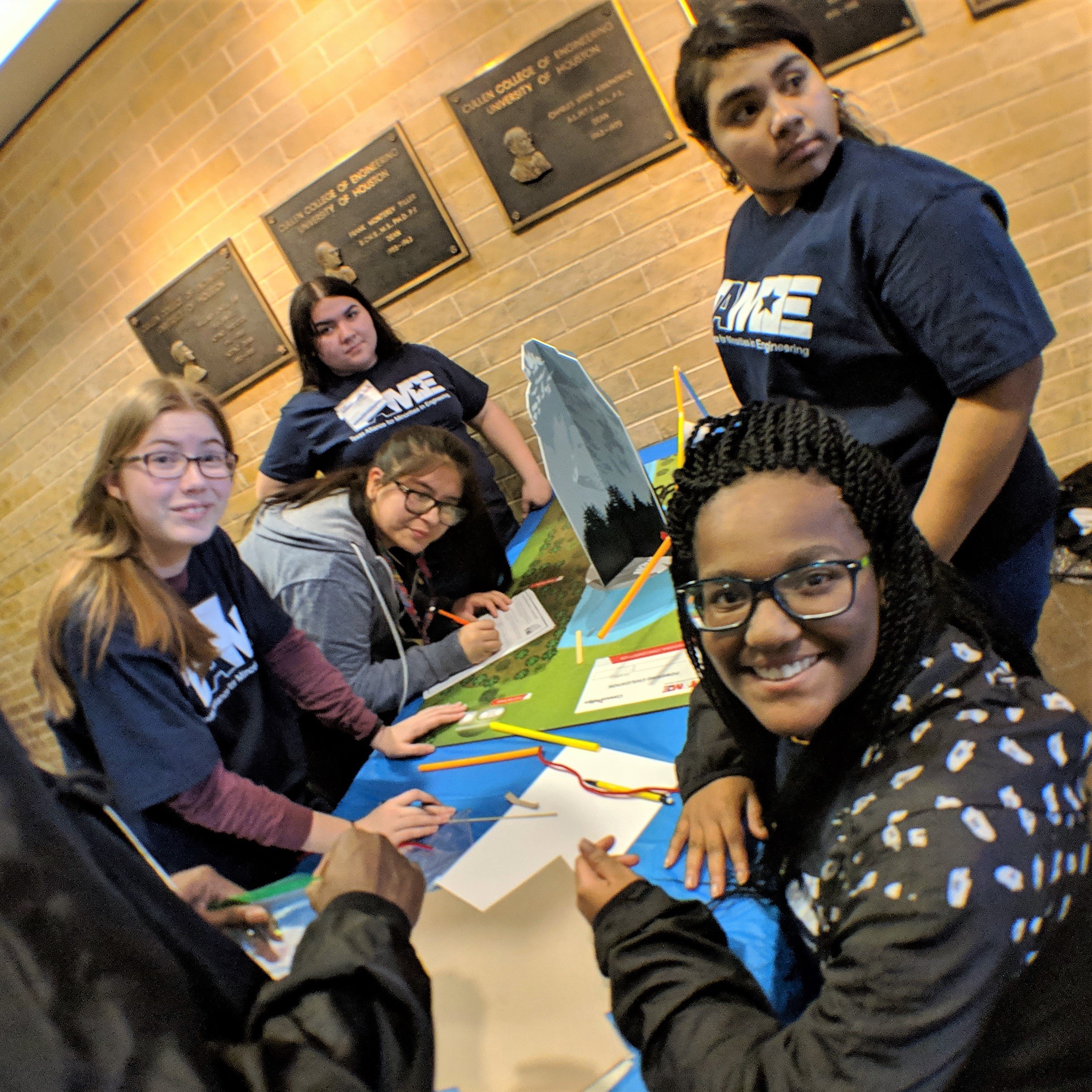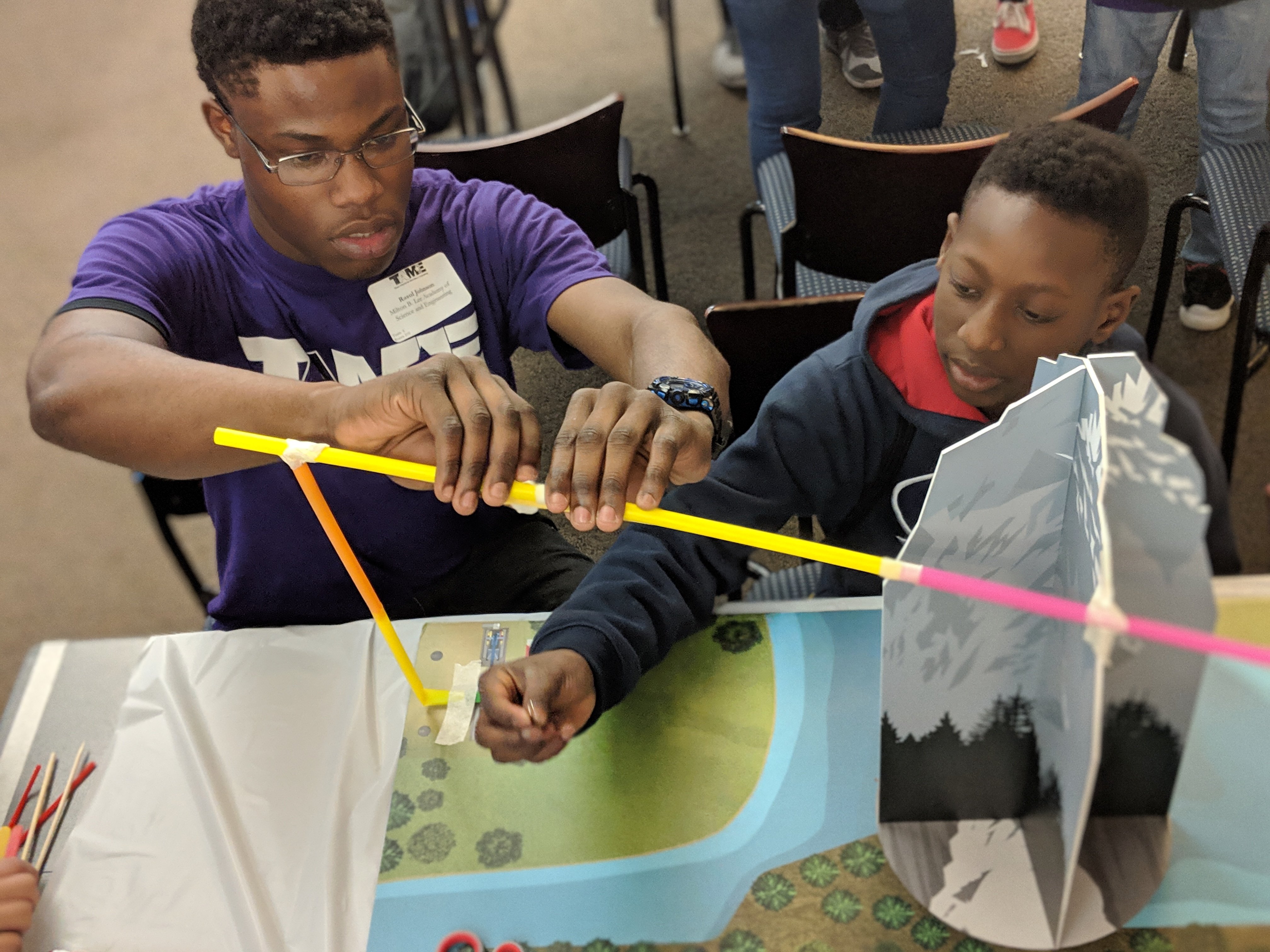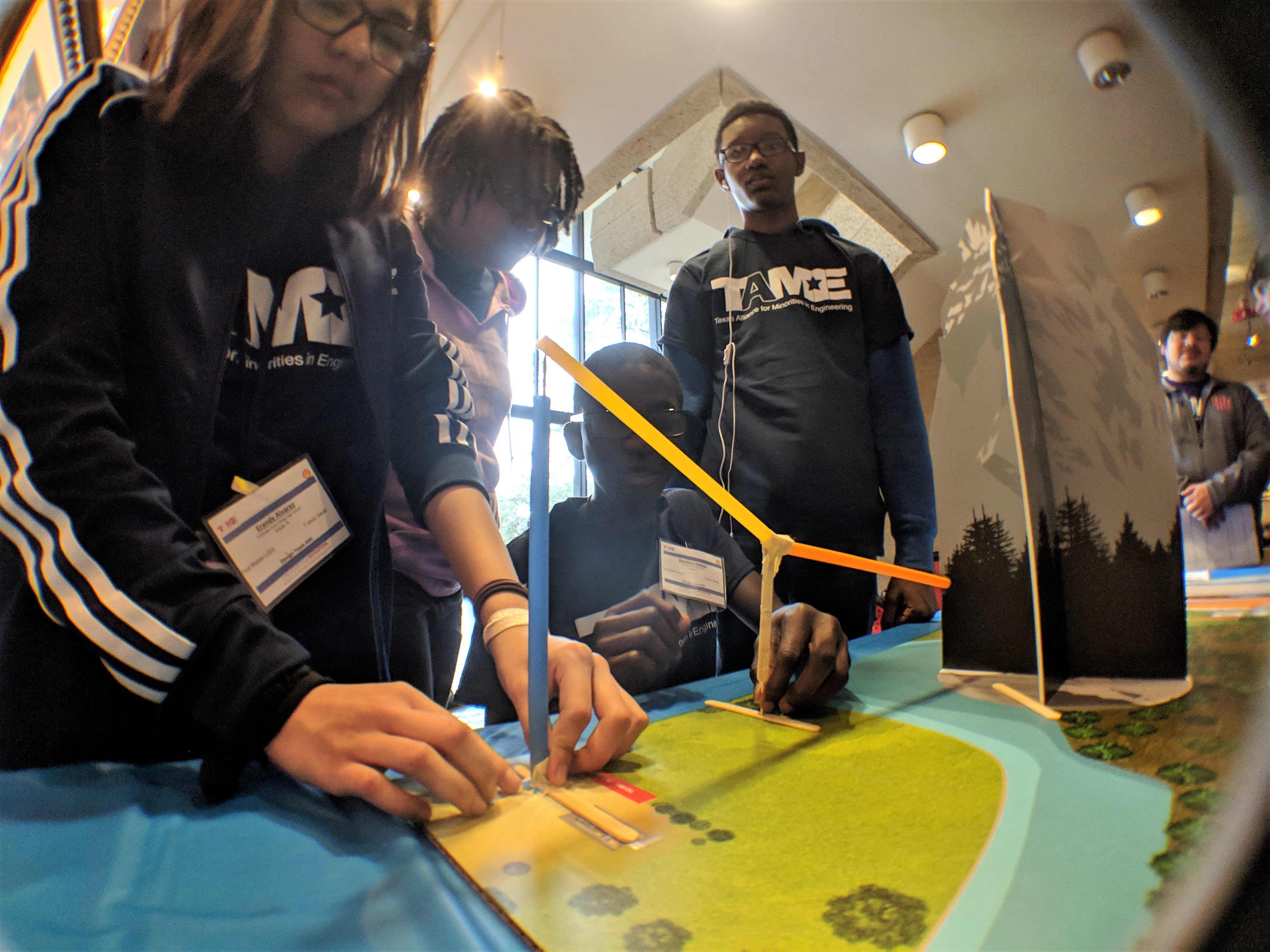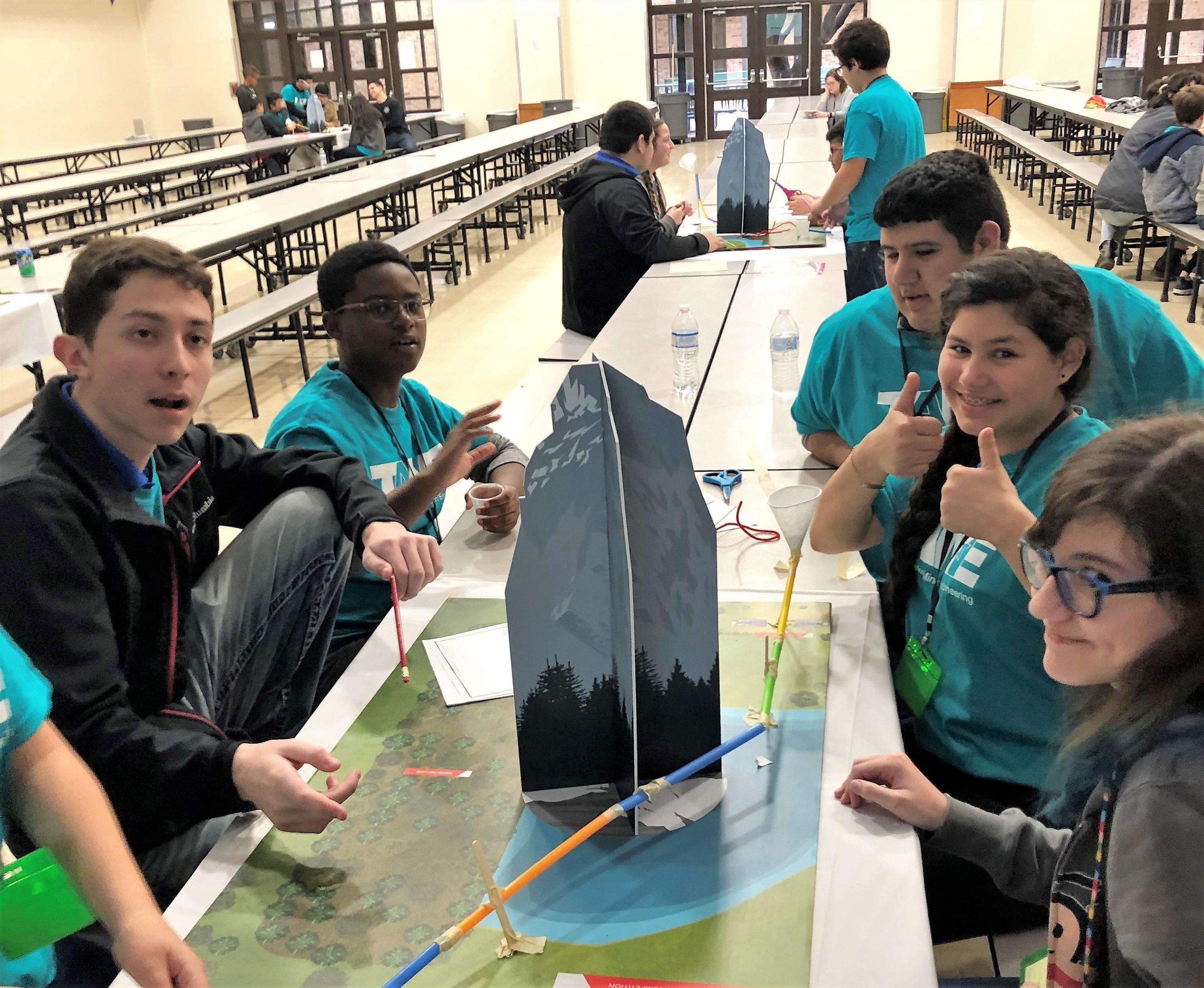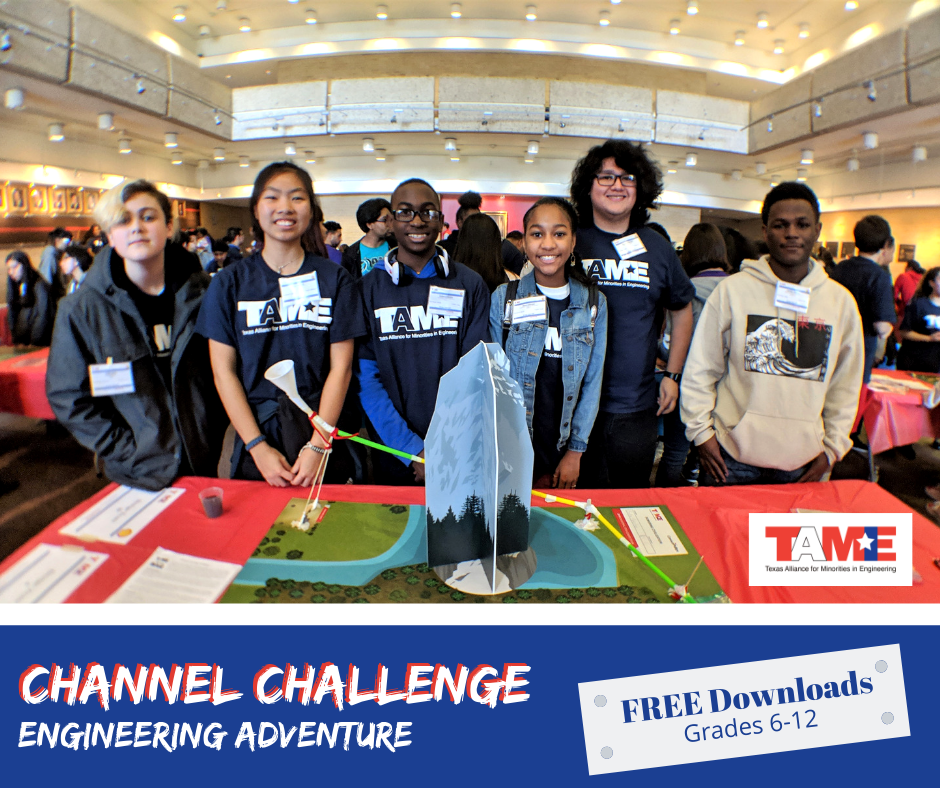
Welcome to TAME Engineering Adventures! Our goal is to help you challenge your students with hands-on learning.
Channel challenge! This Engineering Adventure is to design and build a channel to transport fluids (represented by BBs) across the landscape. We’re offering a classroom adaptation of the Engineering Design Challenge for the 2019 Divisional STEM Competitions, hosted at 14 different chapters around Texas. This year’s challenge was developed by engineers from ConocoPhillips.
It’s a great way to get your TAME Club members to start thinking like engineers in preparation for our STEM Competitions.
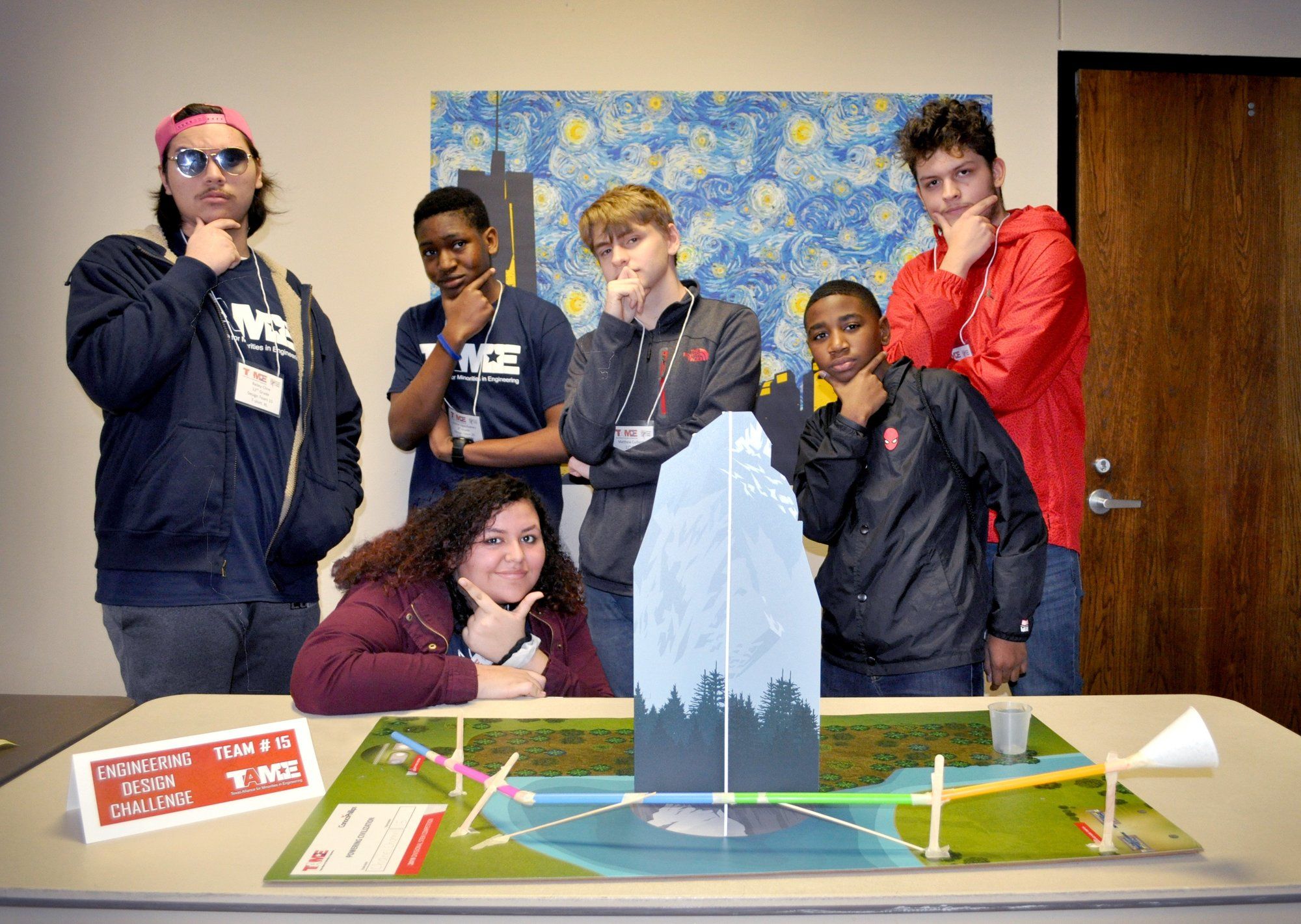
Photo of Team 15, “Chanel Channel,” Engineering Design Challenge Judges’ Choice winners from the 2019 Dallas Divisional STEM Competition.
Introduction: How to think like an engineer
Photo of students discussing ideas during the Engineering Design Challenge at the 2019 San Antonio Divisional STEM Competition.
Competition Adventure: Channel Crossing Challenge! 2019 Divisional Engineering Design Challenge
At ConocoPhillips (COP), STEM professionals design, build and maintain channels to transport fluids (water, oil and gas) across varied, rugged landscapes.
The COP team designs the channels so that the maximum amount of fluids are moved from one location to the other while keeping construction and maintenance costs low. The COP team also works together to make sure that the project is completed on time and makes careful use of the areas that are approved for this work. The team tries to reduce environmental impact by not having any spills during channel construction or transportation of fluids.
Design Brief:
Design a channel to transport fluids (represented by BBs) across the landscape placed at your work station. The fluids (BBs) must move because of gravity (flow from higher to lower levels) and will need to move from the entry zone to the collection zone within 30 seconds. You have 60 minutes to design and build a covered channel to transport the fluid.
Your team will present your design concept and explain why you chose your materials and route. You will explain the strategy you used in moving the fluid (BBs) across the landscape. Teams will earn points for the amount of fluid that is delivered in 30 seconds. Points will be awarded based on the amount of fluid delivered to the collection circle and points will be taken away for fluid spilled out of the channel.
Do not underestimate the weight of the “fluid.” You have been given 10 BBs to test with. During the design process, judges will come to each team and show you the maximum amount of BBs that must be moved through your channel during judging. The weight of the fluid is significant and should be considered during your design process.
The PowerPoint presentation and Student Team Instructions (see downloads) were used at the 2019 Divisional STEM Competitions, and they will lead you through the Design Challenge from concept to scoring. You can decide whether you want to follow the guidelines to the letter, or simplify for your classroom.
Primary objectives: Work together to build a closed channel to transport fluids, while making trade-offs to balance between cost, quality, and time.
Suggested time: 60 minutes
Scoring Summary: Get points by: returning unused materials; amount of fluid transported; complete documentation; creative design and teamwork. Lose points by: poor use of materials; spilling fluid (BBs); not paying attention to costs on landscape; incomplete documentation; not working together.
See PowerPoint under downloads for scoring sheet and additional scoring categories.
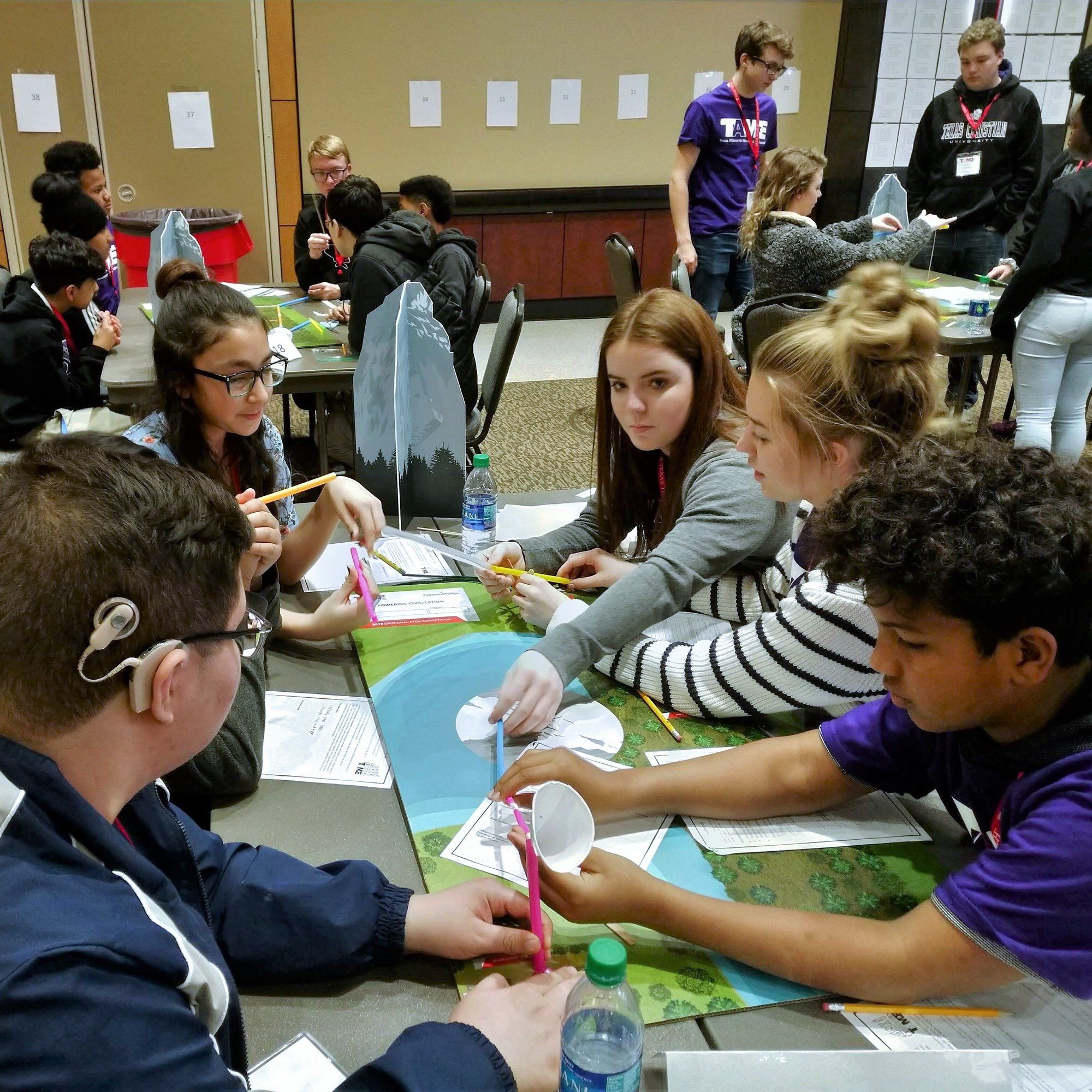
Suggested materials: Club Sponsors, feel free to simplify by using materials on hand. In many cases the competitors did not use all the materials, so it is likely you can run this competition with what you have in your classroom.
Materials per team:
RAW MATERIALS, MAY BE ALTERED:
| 1 sheet chip board |
| 1 sheet card stock |
| 6 craft sticks |
| 4 paper clips |
| 2 skewers |
| Masking tape |
| 1 gallon baggie |
| 4 pipe cleaners |
| 1 paper cone |
| 7 straws |
OTHER RESOURCES, MAY NOT BE ALTERED OR USED IN PROTOTYPE:
| 1 pair of scissors |
| 2 sharpened pencils |
| Design challenge instructions |
| Team number sign |
| Landscape |
| 10 BBs** |
| Small baggie (used for collection) |
| 1 plastic cup (to measure and pour BBs) |
**Black Diamond BBs proved to be the best at mimicking fluid dynamics because they are coated to reduce friction. Uncoated BBs are functional but tended to get stuck in the channel more often. TAME tested several brands and settled on Hornady brand Black Diamond Anodized .177 Steel BBs.
JUDGING MATERIALS, MAY NOT BE ALTERED OR USED IN PROTOTYPE:
Plastic tablecloth
Magnetic sweeper (TAME used this brand from Lowe’s.)
Photo of students mid-discussion during the Engineering Design Challenge at the 2019 Gulf Coast Divisional STEM Competition.
Team member roles:
PROJECT ENGINEER – AVERAGE SALARY: $76,000
A project engineer’s responsibilities include schedule preparation, planning and resource forecasting for engineering and other technical activities related to the project. They may also be in charge of performance management of vendors.
CIVIL ENGINEER – AVERAGE SALARY: $73,000
Civil engineers imagine, design, build, supervise, operate, construct, and maintain infrastructure projects and systems in the public and private sector, including roads, buildings, airports, tunnels, dams, bridges, and systems for water supply and sewage treatment.
CONSTRUCTION ENGINEER – AVERAGE SALARY: $80,000
Construction engineering deals with the designing, planning, construction, and management of infrastructures such as roads, tunnels, bridges, airports, railroads, facilities, buildings, dams, utilities and other projects.
ENVIRONMENTAL ENGINEER – AVERAGE SALARY: $78,000
Environmental engineering deals with the protection of human populations from the effects of adverse environmental factors. It also includes the protection of environments, both local and global, from potentially dangerous effects of natural and human activities.
ECONOMIST – AVERAGE SALARY: $76,000
Economists typically research and analyze economic issues, conduct surveys and collect and analyze data using mathematical models and statistical techniques.
OPERATIONS ENGINEER – AVERAGE SALARY: $73,000
Operations engineers make sure a company’s operations, such as manufacturing and shipping, work properly and meet factory and management specifications. These engineers handle any repairs or upgrades to the machinery and coordinate with other department heads to fine-tune their operations systems.
Photo of students using straws to build a channel during the Engineering Design Challenge at the 2019 San Antonio Divisional STEM Competition.
Ready to tackle the challenge? Download the 2019 Engineering Design Challenge materials using the buttons below to introduce students to this challenge.
Download the PowerPoint Presentation (PDF)
Photo of students using straws to build a channel during the Engineering Design Challenge at the 2019 Gulf Coast Divisional STEM Competition.
Post-challenge reflection:
These activities are a great chance for students to observe the joys and frustrations of collaborative design. Once the competition is over, ask your students to reflect on their experience. Was it easy to work with a team? What was easy and what was hard? What would each student do differently the next time? What would they do the same?
Photo of students during the Engineering Design Challenge at the 2019 Corpus Christi Divisional STEM Competition.
Texas Essential Knowledge & Skills (TEKS) for this Adventure
Middle School TEKS Tie-Ins:
Middle School Math
6th Grade Math
- Apply qualitative and quantitative reasoning to solve prediction and comparison of real-world problems involving ratios and rates
- Generate ratios, fractions, and decimals with the measurements of the channel during the construction and design
- Represent data graphically with dot plots, stem-and-leaf plots, histograms, or box plots to evaluate results of the channel’s performance
7th Grade Math
- Solve mathematical and real-world problems involving similar shape and scale drawings of the channel
- Compare data represented in bar graphs, dot plots, and circle graphs and can use to compare different designs of the channel
8th Grade Math
- Create graph and plots to understand the relationships of data gathered about the channel
- Use previous knowledge of surface area to make connections to the formulas and determine solutions for problems involving rectangular prisms, triangular prisms, and cylinders associated with structures of the channel
Middle School Science
6th Grade Science
- Investigate the relationship between force and motion of BBs in the channel using a variety of means, including calculations and measurements
- Measure and graph changes in motion when testing the BBs in the channel
- Discuss the history and future of energy transformation, including fuel, windmills, and hydroelectric dams
7th Grade Science
- Identify advantages and limitations of different designs such as size, scale, properties, and materials
- Introduce and comprehend the physical and chemical changes of matter and energy
8th Grade Science
- Demonstrate and calculate how unbalanced forces affect the speed or direction of the BBs’ motion
- Practice appropriate use of resources, including disposal, reuse, and recycling of the material used
- Investigate and understand the differences of speed, velocity, and acceleration
- Experience the presence of Newton’s three laws of motion within the motions of the BBs in the channel
High School TEKS Tie-Ins:
High School Math
Algebra
- Consider the associations and causation between the design of the channel and the results of the performance
Geometry
- Have students sketch the top, side and front views and use those views to find the surface area of the the channel
- Have students design and build models with different geometric shapes to navigate with the channel
- Help identify two-dimensional shapes of different cross sections of the three-dimensional shapes of the channel and landscape
High School Science
Chemistry
- Students can collect data and make measurements with precision and record data using International System (SI) units
- Organize, analyze, evaluate, make inferences, and predict trends from data; and communicate valid conclusions
- Exposure to energy and its forms, including kinetic, potential, chemical, and thermal energies present within the channel
Physics/Integrated Physics and Chemistry
- Students can collect data and make measurements with precision and record data using International System (SI) units
- Organize, analyze, evaluate, make inferences, and predict trends from data; and communicate valid conclusions
- Describe and calculate the motion of the BBs in the channel in terms of position, displacement, speed, and acceleration
- Assess the relationship between force, mass, and acceleration, noting the relationship is independent of the nature of the force
- Students can develop and interpret free-body force diagrams of their channels
Earth & Space Science
- Discuss the optimal locations for channels in different geographical areas, such as near mountains, cliffs, canyons, ocean bluffs, and offshore turbines in order to apply Fluid Earth concepts
Looking for more?
TAME offers more in curated idea boards on Pinterest. If you liked these, you’ll love our Engineering: Activities for All Ages board!
With more than 6,000 pins organized into over 50 different boards, TAME’s Pinterest presence is specially curated to help teachers, parents, and students of all ages get excited about STEM.
